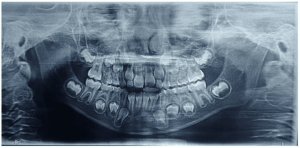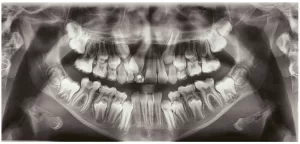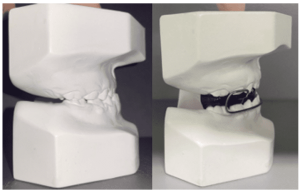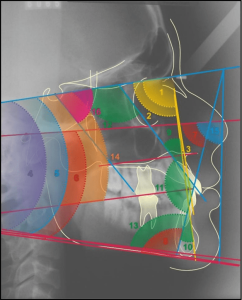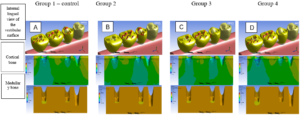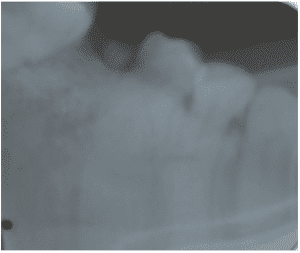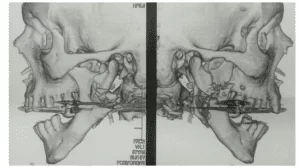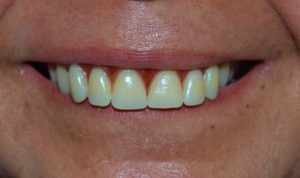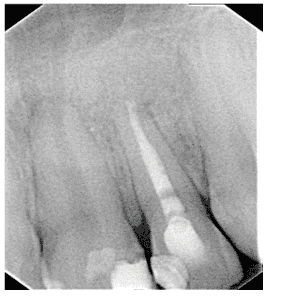ROCHA, Suyanne Aley Lima [1]
BARBOSA, Luíza Augusta Rossi [2]
ROCHA, Suyanne Aley Lima; BARBOSA, Luíza Augusta Rossi. Relationship Between Cross-Bite and Chewing Type in Children: A Review. Multidisciplinary Scientific Journal. Edition 07. Year 02, Vol. 02. pp. 38-46, October 2017. ISSN:2448-0959
SUMMARY
Cross bites are the class I malocclusions most frequently found in deciduous and mixed dentitions, with a prevalence ranging from 8 to 16%, according to the majority of authors consulted. They may be anterior or posterior and may be classified as dental, functional or skeletal. The anterior crossbite is characterized by an abnormal vestibulolingual relationship between the upper and lower incisors, in which the anterior mandibular teeth are buccally anterior superior teeth. This article aims to address the importance of early intervention, the application of primary stability, in a multidisciplinary approach, necessary to maintain the normal occlusion obtained by treatment in the deciduous or mixed dentition. A brief integrative review was carried out and the electronic bases of periodicals: Virtual Health Library (VHL), Medline, Scielo, and Lilacs, articles in Portuguese language or translated, that dealt with the object of the work were searched. The treatment of bites crises should be performed as early as possible, including a psychological evaluation of the child to know if she has sufficient understanding to accept treatment. Chronologically we could stipulate as a minimum age about four years. The importance of early intervention in cross-bite in children was emphasized, being the criterion of choice for the treatment of the previous cross-bite the fixed inclined plane and for cross-bite posterior the quadrilateral apparatus.
Key words: Chewing, Child, Cross-bite.
INTRODUCTION
In the literature there is a wide discussion about occlusal alterations. Most authors and professionals agree that malocclusion is not a problem related only to permanent dentition, being present also in decidua and mixed
The occlusion can be defined as the set of functional and dynamic relationships between the occlusal surfaces of the teeth and all structures of the second stomatognathic system. To define malocclusion, Teixeira et al. (2007) report that it is the morphofunctional deviation of the masticatory apparatus during dental occlusion.
Robocado et al. (1987) defined the stomatognathic system as a unit of the organism formed by maxilla, mandible, dental arches, salivary glands, nerves, vessels, temporomandibular joint (TMJ) and muscles.
And considering that the deciduous dentition can be affected by deleterious changes, a stable occlusion depends on the result of the forces acting on the teeth and the balance of these serves to maintain this stability. In addition, the balance of the entire stomatognathic system can be considered in terms of occlusal stability (MOLINA; MOYERS, 1991).
Crossbite is an alteration characterized by the inability of the two arches to occlude normally in the lateral and / or anteroposterior relationship, and may be caused by localized problems of tooth position, alveolar growth, or due to bone discrepancy between the maxilla and mandible (Janson et al., 2002).
In the present study, cross-bite is a malocclusion frequently diagnosed in mixed-dentition children and may be defined as an alteration resulting from inadequate positioning of the upper teeth in relation to the lower teeth, visualized during occlusion, and may be present both anterior and posterior.
The influence of unilateral crossbite on the development of facial asymmetry has been reported. Cross-bites are frequent malocclusions, causing changes in the profile when not treated early, since they are not self-corrected with eruption of permanent teeth (KUTIN & WEST, 1969).
According to PLANAS (1988), it makes the early diagnosis as a facilitator of the crossbite treatment, because if late, it may lead to irreversible bone dystrophies.
In a study carried out by Martins et al. (1994), they presented a prevalence of anterior crossbite in about 7.6% of children, affecting about 1% of children between 2 and 6 years of age. The etiology of the anterior crossbite has multifactorial ties, and may belong to the class of hereditary anomalies resulting from maxillo-mandibular discrepancy usually due to mandibular hyperdevelopment, maxillary hypodevelopment or in some situations the combination of both factors.
Chewing is a physiological act for the purpose of breaking food into smaller particles, preparing them for swallowing and digestion. It is considered the most important function of the stomatognathic system, in which it involves neuromuscular and digestive activities. While the functions of breathing, sucking and swallowing are innate and initially controlled reflexively, chewing is a learned function and depends on many factors (SIMÕES, 1975).
Alternate bilateral mastication is the physiological and ideal mastication of the human being, with masticatory cycles both on one side and the other, and with the presence of rotational movements of the mandible according to Amaral (2000). It is performed with the lips occluded, it is pointed out as mature pattern of chewing (CATTONI, 2004).
SIMONES (1985) places mastication as one of the most important elements in growth, not only in the lower floor but also in the middle floor of the face, and as an element responsible for the development of the entire stomatognathic system. During the chewing operation the structures will excite differently depending on the chewing side.
This study aimed at understanding the prevalence of crossbite in children in order to emphasize the importance of early treatment, to identify the profile and incidence of crossbite patients, and to associate mastication with crossbite in patients with deciduous and mixed dentition.
We used integrative review methods and searched the electronic bases of periodicals: Virtual Health Library (VHL), Medline, Scielo; and Lilacs, articles in Portuguese or translated, that deal with the object of work. A total of 44 articles were found in this total. This search was performed using the descriptors: Chewing, Crossbite, Child.
CRUSADE BITE: Factor predisposing to skeletal alteration
The crossbite can be anterior and / or posterior. The prevalence of crossbite for the deciduous dentition varies according to authors between 7 and 16%, with a predominance of unilateral posterior crossbite (PAIVA; SILVA; VADIACAZ, 1991).
The etiology of crossbite is well diversified and may present frequency and variations in the different age groups. Functional anterior crossbite is frequently found in deciduous and mixed denture phases, presenting a strong environmental character. This specific type of crossbite is characterized by functional mandibular protrusion, caused by interference in the trajectory of the mandibular closure.
There is premature contact during centric occlusion, leading the child to adopt a mandibular posture deviated by accommodation. When such a protruded jaw posture is not corrected early, it may cause long-term deviations in the growth and development of the face, which may result in asymmetry, with aggravating factors only corrected by orthognathic surgery.
Linder et al. (1988) reported that the finger sucking habit is the most important etiological factor in unilateral crossbite.
The duration and intensity of the sucking habit has a negative influence in reducing the width of the jaw in children with unilateral crossbite. Thumb sucking affects the transverse dimension in the canine region more than the suction of pacifiers. Overbite was more negatively influenced by thumb sucking than by pacifier or any other finger.
Although aggravating in adulthood, the prognosis of early intervention of functional anterior crossbite is quite favorable, since there is no skeletal involvement at this stage; in the same way, that the treatment time is relatively short in these cases.
However, it is essential to perform a correct diagnosis, capable of differentiating the crossbite caused by a postural alteration of the mandible, that caused by a disproportionate growth of the bone bases in the sagittal plane. The recommended method for differential diagnosis is the comparison of the habitual occlusion of the patient (MIH) with the occlusion resulting from the mandibular manipulation leading the condyles in centric relation (CR) (THILANDER et al., 1995).
Anterior crossbite may still occur due to occlusal interference in the anterior region, which characterizes a secondary slip from the mandible to anterior.
According to Ngan et al. (1997) this change can be classified as:
- Tooth: occurs due to a change in the inclination of one or more teeth, ie, upper tooth positioned by palatine with vestibulovulsion of the antagonist tooth, the maxillo-mandibular relation being correct. They present class I molar relationship and coincidence of the centric relation and maximum intercuspation.
- Functional: it is the result of an early installed dental interference, which forces the jaw to move, in order to obtain maximum intercuspation. In a centric relation, the incisors are in a top-to-bottom relationship, with the molars separated, but in a class I molar relation. When the mandible slides from centric relation to maximum intercuspation, the incisors cross and the molars tend to Class III relationship. The profile can be straight or concave.
- Skeletal: occurs due to an asymmetry or lack of harmony of maxillomandibular bone growth. The peril will be straight or concave in the centric relation. The upper incisors are often bent forward and the lower incisors are tilted back to compensate for skeletal dysplasia.
The etiology of malocclusions can be divided into extrinsic factors and intrinsic factors, according to Graber (1965).
Extrinsic factors include: physical entities, pressures, abnormal habits, idiopathic phenomena, pre and postnatal trauma, which may result in facial deformities, habits such as finger suction, tongue projection, lip suction and bite, posture body and onicophagy can interfere with the regular pattern of facial growth, incorrect restorations.
Intrinsic factors include abnormalities in quantity and size of dental elements, abnormal labial frenulum, premature loss of dental elements, prolonged retention and abnormal resorption of deciduous teeth, delayed eruption of permanent teeth, abnormal eruption of dental elements, ankylosis , caries.
The neuromuscular system, due to the effects of reflex contractions on the skeletal bone and dentition, acts primarily on dentofacial deformities. Changes in bone base growth may alter occlusal relationships and functions. Inheritance influences the morphological characteristics, the growth and development of the patient, there are also systemic, endocrine and local diseases influencing the shape of the arches and bone bases;
According to Marchesan (2000), he reports that in unilateral crossbite there is a decrease in vertical space and the impossibility of performing the balancing movement on this side, causing the individual to chew on the crossed side.
The correct diagnosis and the early treatment are fundamental to obtain occlusal, aesthetic and functional balance. The flat direct traces are indicated for the treatment of functional anterior crossbite by the concepts of neuro-occlusal rehabilitation.
In the anterior crossbite can be treated early using the fixed inclined plane, it is an acrylic apparatus, fixed on the anterior teeth. Its confection is simple and can be done on an inferior model or directly in the child's mouth in a session. It acts as a guide anterior plane, applying a slightly directed buccal pressure on the teeth in cross-bite relationship. Pressure is exerted whenever the patient closes the mouth to chew or swallow. At the moment of the inclined plane, an opening is seen in the posterior buccal segments when occluding (WEINBERG, 1975).
It is very important to differentiate the functional unilateral posterior cross bite from true unilateral posterior crossbite because the mechanotherapy used is different. In true unilateral posterior crossbite a unilateral expansion of the arch is developed and bilateral unilateral posterior crossbite a bilateral expansion.
According to Silva et al. (1988), the quadrilateral apparatus is well indicated in cases of bilateral atresia of the upper arch with or without functional unilateral posterior crossbite, being well tolerated by the patients, causing little alteration of the normal functions of the oral cavity.
According to Ricketts (1979), the quadrilateral apparatus should be used in the following cases: Single or bilateral posterior cross bites. Cases that require small expansion in the mixed or permanent dentition. Lack of space. Unilateral or bilateral cleft palate.
DISCUSSION
Crossbite is an occlusal alteration that is also present in the deciduous dentition. Therefore, it is extremely important for the dentist to know the profile of these patients and the prevalence of the cross-bite in order to intervene in time to prevent dysfunctions of greater proportions.
According to Jacobs (1989) he discussed the function of spring removable appliances for treatment of anterior and posterior crossbite. The cases presented demonstrated that the removable appliances were the instruments of choice in the first stage of correction of posterior crossbite and the final treatment completed with the fixed apparatus.
The author evaluated both posterior and anterior crossbite patients or both. It has been found that the removable appliances are preferred for the treatment of anterior crossbite, having the most limited function in the treatment of posterior crossbite. In some cases its use is limited to the first phase of treatment (JACOBS, 1989).
According to studies by Douglas (1994), it shows that only 10% of people with natural dentition present simultaneous bilateral mastication, while 75% have an alternating bilateral masticatory pattern. In the remaining 15%, chewing is only one-sided, right or left, and may result in a posterior crossbite.
The physiological development may start from a neural excitation. On the contrary, if it is pathological the developmental response will be similarly pathological.
Based on these concepts, Planas (1997) suggested that the treatment of neuro occlusal rehabilitation (RNO) should be based on discovering where, when and how to act in the receptive neural centers that provide the response of the Stomatognathic System, physiologically stimulating them and necessary to achieve a normal and balanced development response.
Thus, the earlier the neural and muscular deprogramming of the pathological effects and the consequent rehabilitation of the physiological signals, the shorter the time required to correct the alteration of the organ (muscle / tooth) function.
CONCLUSION
It is important to conclude that cross-bite treatment should be performed as early as possible. This includes a psychological assessment of the child to see if he or she has sufficient understanding to accept treatment. Chronologically we could stipulate as a minimum age about four years. The type of device to be used depends on the age of these patients and the complexity of the case.
Therefore previous crossbites when untreated, cause erosion in the clinical crown of upper and lower incisors, inflammation, periodontal tissue damage poor dental positioning of other teeth, so diagnosis and proper planning are imperative by returning facial symmetry .
REFERENCES
AMARAL, D. B. Unilateral chewing x normal occlusion: a study of its occurrence in children aged 4 to 5 years. Rev CEFAC. 2000; 2 (2): 23-30.
CARVALHO, L. C .; CASA, M. A. Updating in dental clinic. São Paulo: Artes Médicas, 2000.
CARVALHO, O. E. B. R. et al. Study of the prevalence of crossbites in deciduous and permanent teeth in patients examined in the orthodontic discipline of UERJ. R Dental Press Ortodon Ortop Facial, Maringá, v. 5, n. 2, p. 29-34, Mar./abr. 2000.
CATTONI, D. M. Change in chewing and swallowing. In: FERREIRA, L. P., BEFI-LOPES, D. M., LIMONGI, S. C. O. Speech therapy therapist. São Paulo: Roca; 2004. P. 277-84.
DOUGLAS, Carlos Roberto. Treatise on Physiology Applied to Health Sciences. However, Robe, 1994.
GHERSEL, E.L.A .; SANTOS, N.P .; GUEDES-PINTO, A.C .; ABRÃO, J. Subsequent crossbites: diagnosis and treatment. Rev Odontopediatria, São Paulo, v.1, n.2, p.73-82, april / jun. 1992.
GRABER, T.M.Etiologia de Malocclusion-general or extrinsic factors: In: Orthodontics -principles and practice: Buenos Aires, Mundi 1965b.Cap.6, p-161-219.
JANSON et al. Total Cross-Bite Treatment: Two-Step Approach R Clin Ortodon Dental Press, Maringá, v. 3, n. 5, p. 00-00 – out./nov. 2004
JACOBS, S.G. Theth in crossbite; The role of removable ampliances.Aust dent J.34 (1) -20-28,1989.
KUTIN, G .; HAWES, R.R. Later cross-bites in the deciduous and mixed dentitions. Am. J. Orthod., St. Louis, v.55, n.6, p.491-504, Nov. 1969.
LEE, B.D. Correction of crossbite. Dent Clin North Am 1978 Oct; 22: 647-68.
LINDER, A. et al. Post-Crossbite. Scandinavam Journal Od Dental Researc. 411-4171986.
MARCHESAN, I. Q. The speech pathology treatment with alterations of the stomatognathic system. Int J Orofacial Myology. 2000; 26: 5-12.
MARTINS, D.R .; ALMEIDA, Z. R. DAINESI, E. A. Anterior and posterior crossbites. Odonto Master. Orthodontics. v. 1., n. 2, p. 1-19, 1994.
MELO, FABIOLA. The mastication in the occlusal alterations.Monography of conclusion of course of specialization in oral motricity presented at the Center of Specialization in Clinical Phonoaudology of Curitiba as requisite to obtain the title of specialist.abril 1999.
MOYERS, E.R. Orthodontics. 4a. ed., Rio de Janeiro: Guanabara Koogan, 1991.
MOLINA, F. O. Craniomandibular pathophysiology. São Paulo, Pancast, 1995. 677p.
MOYERS, R. E. Orthodontics. Rio de Janeiro, Guanabara Koogan, 1991. 483p
NEUMANN, Graber. Removable Orthodontic Devices. 2a. ed., São Paulo: Panamerican Medical Publishing House, 1987.
NGAN, D.M.D.P .; ANNIE, M.H.U.; FIELDS, H.W.J.R.Treatment of class III problems begins with differential diagnosis of prior crossbites. Pediatric Dentistry. 1997; 19, 386-395
PIZZOL, Karina. Influence of Unilateral Mastication on the Development of Facial Asymmetry; Araraquara, Revista Uniara.n.15.2004.
PLANAS, P. Neuro occlusal rehabilitation (RNO). 2.ed. New York: Ed. Medical and Scientific, 1997; 355p.
PAIVA, L. A. Basic Preventive Orthodontics. Cap. 2, p. 31-95, Ed., Medical Arts, 1992.
RIBEIRO, M.C. Pre-and post-operative speech-language pathology in orthognathic surgery. J Bras Fonoaudiol. 1999; 1: 61-8.
RJCKETTS, R.M .; Dr. Robert. M. Ricketts on ear treatment J.C1in.Ortodont. 13: 181-99, 1979
ROSENBACH, G .; MARCHIORO, E.M. Anterior crossbite in the deciduous dentition – report of a clinical case. Rev Odonto Ciênc, Porto Alegre, v.10, n.19, p.17-27, jun. 1995.
ROBOCADO, S.M .; TAPIA, V. Radiographic study of craniocervical relation in patients under orthopedic treatment and the incidence of related symptom. J cranioman-dib Pract 1987; 5:13.
SALGADO, L.R.B .; SALGADO, L.P.S. Crossbites. Importance of early treatment. Rev Bras Odontol, Rio de Janeiro, v.43, n.2, p.30-40, Mar./abr.1986
SANCHES, L.J.M .; SANTOS, P. THE.; MARTINS, J.C.R .; RAVELI, D.B .; GANDINI, J.R L.G. Treatment of anterior cross bite with acrylic inclined plane. Rev Bras Odontol, Rio de Janeiro, v.50, n.2, p.14-18, Mar./abr. 1993.
SANTOS, J.J. Occlusion – principles and concepts. 5a. ed., São Paulo: Livraria Santos, 1988.
SAKIMA, T.; GANDINI, J.R.L.G .; SAKIMA, M.T. Crossbite: diagnosis and treatment within reach of the general practitioner. Update in the Dental Clinic. São Paulo: Before Doctors, 1992. P. 279-88.
SIMÕES, Wilma Alexandre. Functional Jaw Orthopedics – seen through neuro-occlusal rehabilitation. São Paulo: Livraria Editora Santos, 1985.
SILVA, F.O.G et al. Cephalometric changes occurred in the mixed dentition after the use of fixed expander type quadriélice.Ortodontia. 19: 22-23, 1986.
TAKEUTI, M.L .; JOSÉ, A.P.M .; FERREIRA, S.L.M .; WANDERLEY, M.T .; RODRIGUES, C.R.M.D. Characteristics of occlusion of patients attended at the pediatric dentistry clinic of the FOUSP undergraduate course. UFES-Rev Odontol, Vitória, v.3, n.2, p.69-75, jul./dez. 2001.
TERADA et al, Use of Progenic Apparatus for Correction of Anterior Crossbites; Available in Dental Press Journal of Orthodontics and Maxillary Orthopedics; Volume 2; nº 2 March / April -2007.
TEIXEIRA, M.J .; YENG L.T .; KAZYIAMA, H.H.S.Physiopathology of musculoskeletal pain: Teixeira MJ, Yeng LT, Kazyiama HHS contributors.Myfacial pain syndrome and musculoskeletal pain.São Paulo: Roca, 2007.p.53-70.
THILANDER, B. Basic mechanisms in craniofacial growth. Acta Odontol Scand 1995 Jun; 53: 144-55.
VADIACAZ, G.P .; ROBERTS, M. W. Primary posterior crossbite. Diagnostic and treatment … The Joumal of Clinical Pediatric Dentristy. 6 (1), 1991.
WOITCHUMAS, et al; Previous Crossbreed Bites: Diagnosis and Treatment of Pseudo-Class III – Report of a clinical case; gasso Fundo, v.6, n. p.23.8, Jul / Dec. 2001.
WEINBERG, R.L.The former crossbite: Report of cases J.Am.Dent.Ass., 90: 621-4,
WEST, E.E. Treatment objectives in the deciduous dentition. Am J. Orthod., St. Louis, v.55, n.6, p.617-632, June 1969.
[1] Odontologist. Specialist in Orthodontics by the Faculty of Technology of Sete Lagoas-FACSET-Public Servant Dentist in Montes Claros prison system
[2] Profª Master of the State University of Montes.

